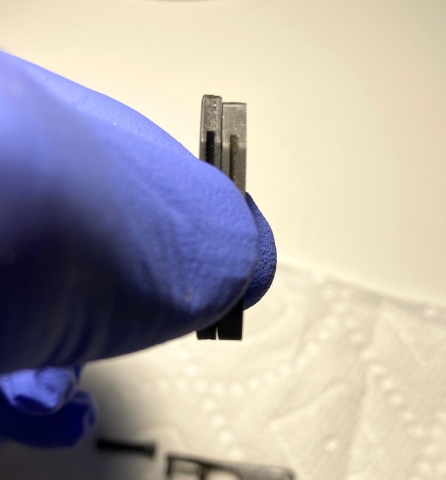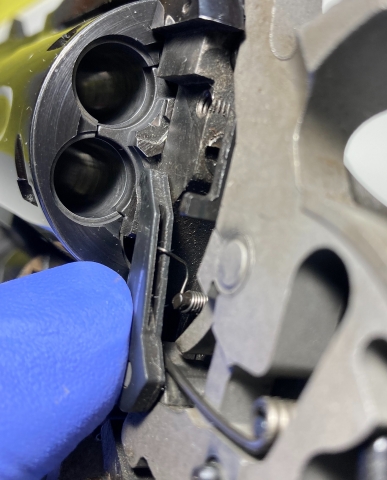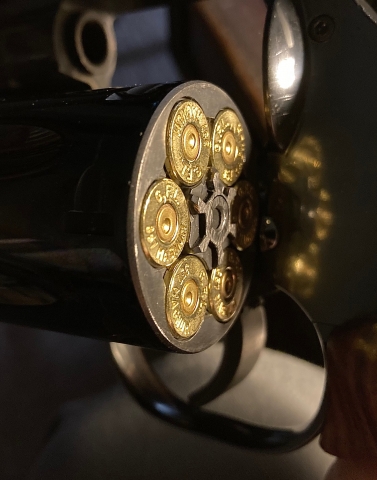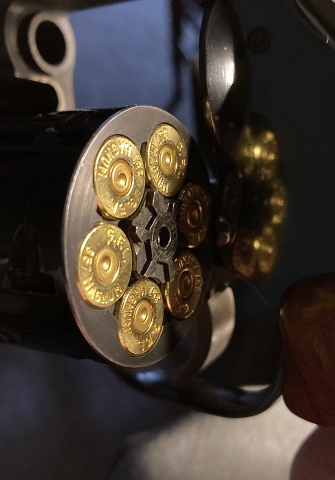October 17, 2017
 Offline
OfflineWell, this is sort of a range day report, but there are no target photos. I can say however that I've never hit 8 out of 10 rams before at an IHMSA Field Pistol match using any of my other .357 mag revolvers. I love this gun! I have had this thing completely apart, and there are some small differences from later models that you might find interesting. One thing that was the same as my other early DW's is the rather rough tool marks in the chambers. .38 Specials ejected fine, but Magnums were very tight. So, as with my other DW's I had to use the Flex Hone tool to smooth out the chambers. Perfect now. The attached photos will hopefully show these minor differences: The hand is very different from later guns. It is only .092 thick rather than .110, and is a little longer as you can see in the photo. The hand spring and the transfer bar are also quite different. This porker is number 31xx, and while the hand does have the groove in the back it seems they still used the original hand spring which sits at an odd angle, but works OK. The take up is a little earlier than later guns. In single action the cylinder starts to turn the instant the bolt has dropped unlike the later DW's that have a slight delay. In double action pulling the trigger just against the pressure of the trigger return spring drops the bolt completely, so as soon as the main spring is engaged the cylinder starts to turn. I can see no difference in the hammer throw from later guns in single action, but it seems a little faster in double action. The cylinder chamber recesses are cut a little deeper than later guns; a depth of .055 instead of .044 which gives a little more headspace, and since the cylinder clearance seems to be less this is a good thing. The side plate screws have smooth heads instead of the usual knurled, and the longer screw is definitely a little different as the photo shows. Interestingly, the stud in the base of the grip post looks to have been welded in place rather than staked. 









 Overall, the fit and finish is superb on this revolver, and it is a very enjoyable gun to shoot!!
Overall, the fit and finish is superb on this revolver, and it is a very enjoyable gun to shoot!!
October 17, 2017
 Offline
OfflineOther than changing out the grip there have been no modifications on this gun. The first time the side plate was ever removed it was removed by me over a half century after it was assembled. I am simply describing what I have examined about how this very early DW revolver was made compared to later models. The very first DW’s would have had the same hand (dimensionality) but without the groove which explains why the hand spring has that overly long end that was intended to cross over the entire hand. When they first made the change by adding the groove they didn’t bother to change the spring design (probably using up the springs they already had). They may have changed the spring a little later, but I suspect this was the setup until the redesign that became the 15-1. The hand, hand spring and transfer bar of the 15-1 are identical to the 15-2.
3ric, the very first change made to the models 11 and 12 were the groove in the hand and the new spring. That happened with the introduction of the 14 and 15 in 1971. Your gun does not have the original hand but whoever replaced it kept the original spring. The reason for the change was because the original hand spring wrapped around the hand and rubbed against the sideplate causing it to break. I have a Model 12 that had that happen to. If I start shooting it again or another I have I will replace the hand and spring with the later version. Did you buy the gun new in 1970? As far as the welded grip tang, that too is not original. I can't speak about the cylinder without examining mine which is currently buried in my sardine pack safe.
October 17, 2017
 Offline
OfflineOle Dog, I only recently purchased this Model W12, and it certainly seemed to be in unfired condition. I’ve seen a lot of revolvers in my day, and I would have sworn that I was the first to open this one up. Yet, I defer to your judgment. It seems to function correctly, and I have no plans on changing anything, and since the hand spring isn’t rubbing anywhere I don’t think I’ll experience a failure. I’m assuming the thinner hand was intact through the Model 15 years, and the thicker one began with the 15-1?
I will have to check if the early hands are thinner. I really have not noticed and I have opened and totally cleaned dozens of Dans and many of the porkchops. It may take a while because I am so busy taking care of my other hobbies. Your hand spring is fine. It is not wrapped around the hand like the original spring.
October 17, 2017
 Offline
OfflineThis topic may have been a little misplaced (although I'm not sure exactly where it fits), but I see it as an opportunity to learn something that can be learned in no other way. A little like those gentlemen entering Tutankhamun's tomb for the first time in 5,000 years, we're getting a rare view into the past of exactly how things were done at DW in that first year of production. My only goal in taking the time to dismantle this revolver for the second time in its history was to share what can be learned with the forum. Please believe me; this revolver was completely intact from when it left the factory until I removed the side plate for the first time a couple of months ago. But what interests me most about this gun is the different timing of the bolt, hand and ratchet. It's incredibly fast. To me, changes are usually made for "improvement" purposes, yet I can't find any fault with the way this revolver works. I intend to enjoy shooting it, a lot, and perhaps any faults in engineering or manufacturing may eventually show up. I'll let you know!
October 17, 2017
 Offline
OfflineTwo last dimensions that might be of interest; endplay and headspace. Since this gun is basically factory new it is interesting to me to have an opportunity to measure what these tolerances actually were in 1970. Endplay: .004, and the headspace is right at .060, yet I can make no comparisons to later guns since all three of my DW's are early guns. After the redesigned crane/cylinder from around 1978 it's possible those tolerances may be slightly different.
October 17, 2017
 Offline
OfflineWell, I thought I was done, but then took one more measurement that came to mind. Chamber throat: interestingly .358 as opposed to both the 15-1 and 15-2 which are barely .357. I can’t say what a Model 15 would be, but my guess would be .358 like the W12. Anyone have one lying around to take a quick measurement?

Dans Club
February 24, 2013
 Offline
Offline3ric,i have taken apart many porkchops and dash 2s , both short action and the longer action guns starting with the dash 1s. The only difference in the lock work between any of them ( besides the thickness in the hand, the length of the connector and the size of the hammer face) is the ledge on the trigger that the trigger return spring rests on from the dash 1s onward. The 11,12 14 and 15 have no ledge. The trigger return spring rests on the top of that part of the trigger. It is very hard to replace the sideplate without knocking it off. The little ledge on the later models make it much easier to keep the trigger return spring when replacing the sideplate and it also affects the action. That tiny ledge changes the geometry of the hammer, making the hammer travel further and have less mechanical advantage. Hence a lighter trigger pull. I suspect it also makes the trigger act on the bolt sooner. The arc of raised metal on the early trigger where it rubs the sideplate is shorter than that on the dash 1 and 2s. I noticed your model 12 trigger has that short arc. I bet the 15-2 trigger has a longer arc. It doesn't affect function but is an indication they are different. Try studying the action with the sideplate off and you will see if the bolt is affected sooner by the trigger because of the absence of that ledge.
My bedside nickel model 14 with the short action trigger/hammer is the fastest DA trigger of any of many dozens of revolvers I own. I also swear by the Wolfe trigger return spring as the single best thing you can do to improve the trigger of a Dan Wesson.
1 Guest(s)

 Register
Register Log In
Log In Home
Home












